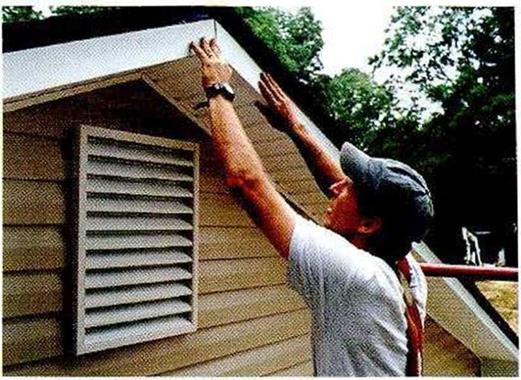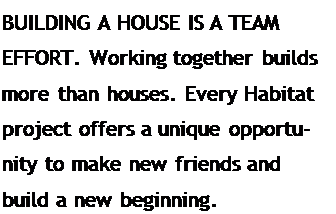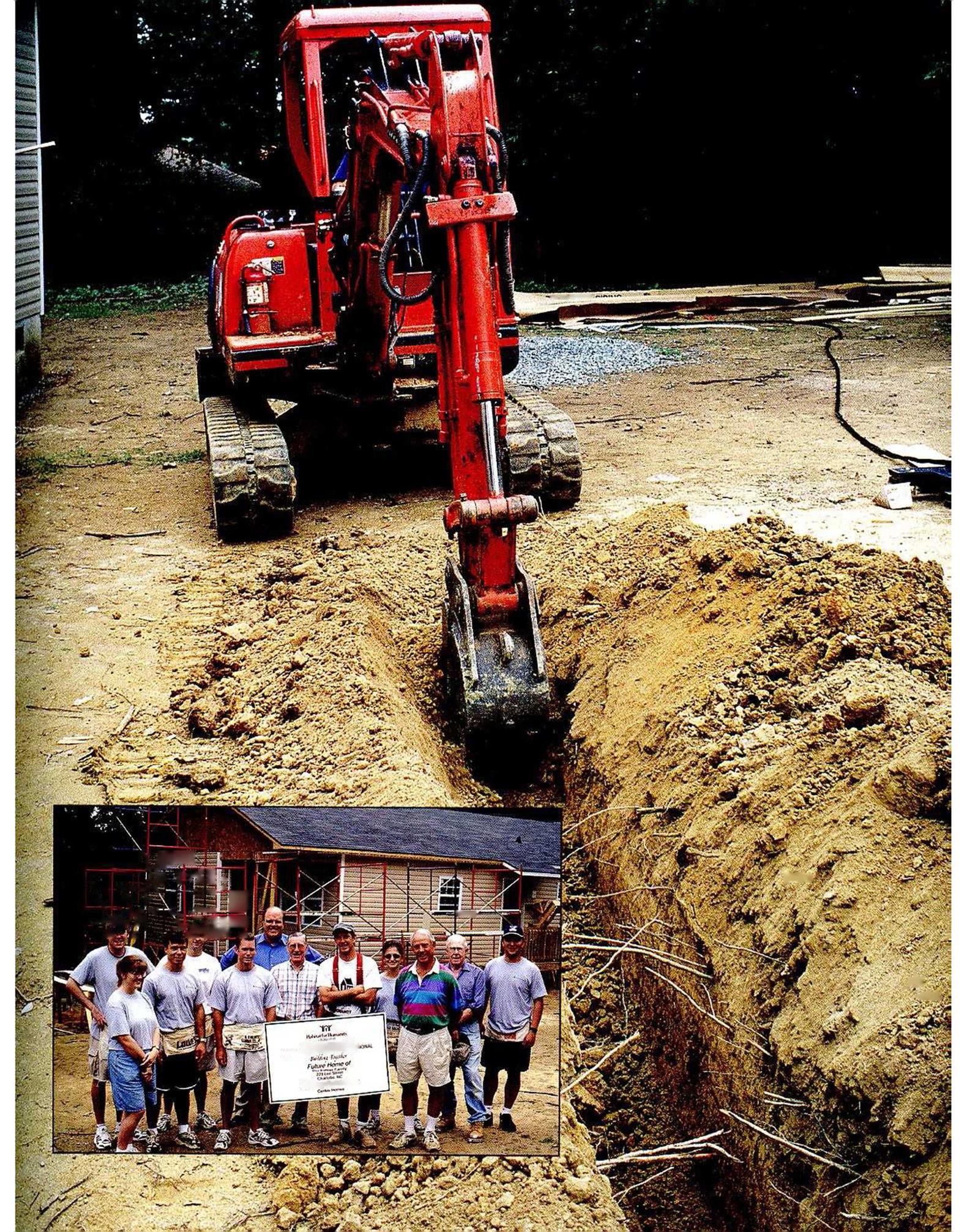Habitat for Humanity International
high on the short-grass prairies of western Nebraska, that huge inland sea of grass where the only constant is the wind whistling across the snow-covered, sagebrush hills. Aged, warped, unpainted clapboard siding hardly slowed the wind and cold. It was an uninsulated farmhouse with no central heating, no electricity, no indoor plumbing, and windows that let in more wind than light. Just 3 ft. from the iron stove in the kitchen, it was Iree/ing. In our bedrooms, even when Mother warmed the sheets with her flat iron, the temperature never got much above what it was outside. Wallpaper, as the saying goes, was used not for decoration, but for insulation.
 After high school, I headed south. The first framing job I worked on was in Los Angeles in 1950. There were lots of carpenters, all wearing white overalls, cutting different pieces of wood with sharp handsaws and nailing them together with 16-oz., curved-claw hammers. The pace was slow and methodical. A wall chalkline would be snapped on the floor. The bottom plate was nailed to the line. Comer posts were then set and a string pulled taut over posts from corner to corner. The length of each wall stud was measured from that string. Once the studs were cut and toe – nailed to the bottom plate, we would stand on
After high school, I headed south. The first framing job I worked on was in Los Angeles in 1950. There were lots of carpenters, all wearing white overalls, cutting different pieces of wood with sharp handsaws and nailing them together with 16-oz., curved-claw hammers. The pace was slow and methodical. A wall chalkline would be snapped on the floor. The bottom plate was nailed to the line. Comer posts were then set and a string pulled taut over posts from corner to corner. The length of each wall stud was measured from that string. Once the studs were cut and toe – nailed to the bottom plate, we would stand on

affiliates. Families that otherwise would not have even dared to dream of owning their own home have been given a “hand up’ to a dwelling that they can actually afford. But make no mistake: This isn’t charity—the houses are not given away. Rather» in addition to shouldering a modest mortgage, the new homeowners put in around 500 hours of “sweat equity,” working with volunteers who help them build their house. In the few years I have lived here in Coos Bay, Oregon, we have built eight houses that have become homes for the families who worked with us. Because of all the volunteer labor, we are able to build these houses for about $30,000 to $35,000, plus land, which results in a mortgage that even low-income families can handle.
lfHFH can build an affordable house, why can’t anyone? First of all, others arc doing it. More than 175,000 owner-builders create new housing units each year. It takes a significant amount of courage, effort, and time, not to mention a piece of land, some money, and help from friends—but it can and is being done. How to build a simple house is not a mystery. It’s rather like putting together Lego blocks or Lincoln Logs, one piece at a time. Many of vou already have the basic skills needed to build a simple house. Just look at the thousands of people who flood places like Home Depot and Lowe’s to buy tools and materials for working around their homes.
If you’re considering building your own home, keep in mind that it is also possible to build a home that is beautiful but, in the long
run, is neither decent nor affordable. Decent housing, for example, coesn’t have leaks that can cause mold and rot, compromising both vonr health and your home. Neither is decent housing full of toxic fumes, which can come from paint, carpet, and a host of other common, seemingly innocuous, materials. A decent, affordable home is energy efficient, well ventilated, and comfortable; built from safe, health-preserving materials; and requires a minimum of upkeep or maintenance. It can also be built from forest products and other materials that are sustainable, so that we don’t further lay waste to our homeland. Building such a home isn’t impossible, but it does take some careful planning.
So, where do you start? There is an old saving, "You can hear a ot just by listening. M Talk to neighbors, contractors, carpenters, building inspectors, and the staff at your local building-supply store. Contact your local Habitat affiliate or HFH International for information. Read the how-to information that comes with many building materials; study this book and others; check out the numerous how-to-build sites on the Web (see Resources on p. 278). Ask questions, work out details and ideas on paper, and gradually the big picture will start to get clearer. Although no single book can answer all the questions you’re likely to have on the subject, it’s my intent to provide a step oy-step guide that will take you from basic planning and design through the actual construction of a simple, decent, affordable house.
BUILDING A HOUSE IS A LONG JOURNEY, and one of the most important characteristics you can possess is optimism. In this context, 1 often think about president Jimmy Carter, who has done so much to promote the work of Habitat for Humanity. Over the years, he has helped build hundreds of houses in the sincere belief that decent housing can be made available to every human being. As you take your first steps toward building a house, remember Mr. Carters optimistic altitude, and make it your own.
![Habitat for Humanity International Подпись: Jimmy Carter-President, Nobel Prize winner, Habitat volunteer. [Photo by Lisa Bell.]](/img/1312/image003_0.gif) The homebuilding process can be intimidating, especially if you haven’t been through a house construction project from start to finish. This book is here to help you. By gaining a good understanding of when, why, and how things are done, you’ll also gain confidence in your ability to build a house that’s comfortable, functional, and affordable. Take care, and hold on to your optimistic attitude. Enjoy the step-by – step journey and all the people who help out along the way.
The homebuilding process can be intimidating, especially if you haven’t been through a house construction project from start to finish. This book is here to help you. By gaining a good understanding of when, why, and how things are done, you’ll also gain confidence in your ability to build a house that’s comfortable, functional, and affordable. Take care, and hold on to your optimistic attitude. Enjoy the step-by – step journey and all the people who help out along the way.
1 ![]()
![]()
 Obtain a Site
Obtain a Site
2 Prepare the Site
3 Design the House
4 Secure the Building Permits
5 Get Organized to Build

|
||||||||||||||||||||
|
||||||||||||||||||||
|
||||||||||||||||||||
|



![Habitat for Humanity International Подпись: HEAVY EQUIPMENT READIES THE SITE. Initial site preparation is usually done with heavy equipment because of the sheer difficulty of clearing, grading, and digging by hand. [Photo Larry Haun.]](/img/1312/image012_3.gif)






Leave a reply